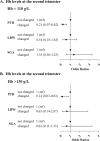High hemoglobin level is a risk factor for maternal and fetal outcomes of pregnancy in Chinese women: A retrospective cohort study
- PMID: 35387646
- PMCID: PMC8988373
- DOI: 10.1186/s12884-022-04636-9
High hemoglobin level is a risk factor for maternal and fetal outcomes of pregnancy in Chinese women: A retrospective cohort study
Abstract
Background: To examine the association of hemoglobin (Hb) levels during gestation with the risk of selected adverse pregnancy outcomes such as preterm birth (PTB), low-birth-weight infants (LBW) and small-for-gestational-age infants (SGA) in Chinese women.
Methods: This retrospective cohort study was conducted in the Department of Gynecology and Obstetrics at the Union Shenzhen Hospital of the Huazhong University of Science and Technology, using routinely collected maternity and hospital data on pregnancies (2015-2018). Hb levels were measured during the second (16-18th weeks) and third (28-30th weeks) trimesters of pregnancy, and pregnancy outcomes were recorded in the hospital information system. Hb levels were categorized into four groups as follows: < 110 g/L, 110-119 g/L, 120-130 g/L, and > 130 g/L. The second group (Hb 110-119 g/L) was defined as the reference group. Statistical analysis was performed using multivariate logistic regression.
Results: A total of 1911 singleton mothers were included. After multivariable adjustment, Hb levels > 130 g/L in the second trimester increased the risk of LBW (odds ratio [OR], 2.54; 95% confidence interval [CI], 1.12-5.76). In the third trimester of gestation, compared with women whose Hb levels between 110 and 119 g/L, women with Hb levels > 130 g/L had an increased risk of LBW (OR, 2.20; 95% CI, 1.07-4.51) and SGA (OR, 2.00; 95% CI, 1.05-3.80). When we compared the highest and lowest quartiles of changes in the Hb across the second and third trimesters, the adjusted ORs were 0.35 (95% CI: 0.18-0.68) for PTB and 0.47 (95% CI: 0.23-0.98) for LBW.
Conclusion: Maternal Hb > 130 g/L was associated with increased risk of adverse pregnancy outcomes. Reduction of the risks of PTB and SGA were observed with the appropriate increase of Hb level during the third trimester.
Keywords: Adverse pregnancy outcomes; Hemoglobin; Low–birth–weight infants; Preterm birth; Small–for–gestational–age infants.
© 2022. The Author(s).
Conflict of interest statement
The authors declare that they have no competing interests.
Figures
References
-
- Scanlon KS, Yip R, Schieve LA, Cogswell ME. High and low hemoglobin levels during pregnancy: differential risks for preterm birth and small for gestational age. Obstet Gynecol. 2000;96(5 Pt 1):741–748. - PubMed
MeSH terms
Substances
LinkOut - more resources
Full Text Sources


